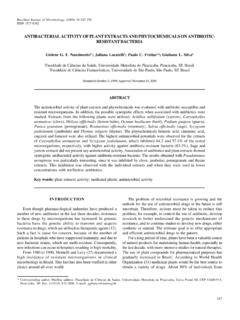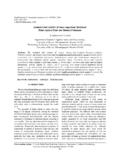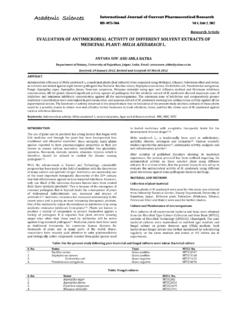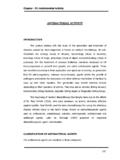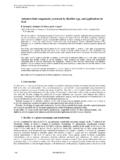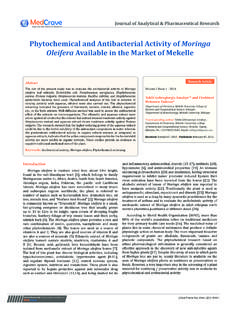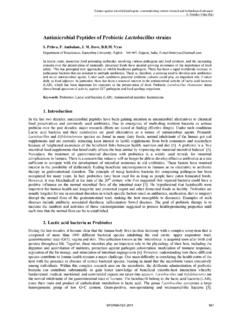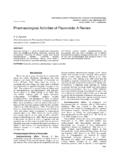Transcription of Bacteriocins from Lactic Acid Bacteria: Purification ...
1 521 Brazilian Archives of Biology and Technology , n. 3 : May 2007 ISSN 1516-8913 Printed in Brazil BRAZILIAN ARCHIVES OF BIOLOGY AND TECHNOLOGY A N I N T E R N A T I O N A L J O U R N A L Bacteriocins from Lactic acid bacteria : Purification , Properties and use as Biopreservatives Jos Luis Parada, Carolina Ricoy Caron, Adriane Bianchi P. Medeiros and Carlos Ricardo Soccol* Unidade de Biotecnologia Industrial; Divis o de Bioprocessos e Biotecnologia; Setor de Tecnologia; Universidade Federal do Paran ; C. P. 19011; 81531-990; Curitiba - PR - Brasil ABSTRACT Biopreservation systems in foods are of increasing interest for industry and consumers.
2 Bacteriocinogenic Lactic acid bacteria and/or their isolated Bacteriocins are considered safe additives (GRAS), useful to control the frequent development of pathogens and spoiling microorganisms in foods and feed. The spreading of bacterial antibiotic resistance and the demand for products with fewer chemicals create the necessity of exploring new alternatives, in order to reduce the abusive use of therapeutic antibiotics. In this context, Bacteriocins are indicated to prevent the growth of undesirable bacteria in a food-grade and more natural way, which is convenient for health and accepted by the community.
3 According to their properties, structure, molecular weight (MW), and antimicrobial spectrum, Bacteriocins are classified in three different groups: lantibiotics and non-lantibiotics of low MW, and those of higher MW. Several strategies for isolation and Purification of Bacteriocins from complex cultivation broths to final products were described. Biotechnological procedures including salting-out, solvent extraction, ultrafiltration, adsorption-desortion, ion-exchange, and size exclusion chromatography are among the most usual methods. Peptide structure-function studies of Bacteriocins and bacterial genetic advances will help to understand the molecular basis of their specificity and mode of action.
4 Nisin is a good example of commercial success, and a good perspective is open to continue the study and development of new Bacteriocins and their biotechnological applications. These substances in appropriate concentrations may be used in veterinary medicine and as animal growth promoter instead usual antibiotics, as well as an additional hurdle factor for increasing the shelf life of minimal processed foods. Key words: Lactic acid bacteria , Bacteriocins , Purification , food preservation * Author for correspondence INTRODUCTION One of the concerns in food industry is the contamination by pathogens, which are frequent cause of food borne diseases.
5 Over the past decade, recurrent outbreaks of diarrhea, combined with the natural resistance of the causative agents, contributed to its status as hazard. The problem of selection of resistant bacteria to antibiotics (Parada, 1980; Chopra et al, 1997; Rao, 1998; Kapil, 2005) and the increasing demand for safe foods, with less chemical additives, has increased the interest in replacing these compounds by natural products, which do not injure the host or the environment. Biotechnology in the food-processing sector targets the selection, production and improvement of useful microorganisms and their products, as well as their technical application in food quality.
6 Parada, J. al. Brazilian Archives of Biology and Technology 522 The use of non-pathogenic microorganisms and/or their metabolites to improve microbiological safety and extend the shelf life of foods is defined as biopreservation (De Martinis et al, 2001). Antagonistic properties of Lactic acid bacteria (LAB) allied to their safe history of use in traditional food fermented products make them very attractive to be used as biopreservatives (Parada, 1984; Caplice and Fitzgerald, 1999). Antibiotics are at present restricted for use in foods and feeds, and Bacteriocins are an interesting group of biomolecules with antimicrobial properties that may represent a good alternative (Jack et al, 1995).
7 The increasing interest in these compounds has stimulated the isolation of LAB producers and the characterization of many novel peptides (Deraz et al, 2005). The successful development of nisin from an initial biological observation through regulatory approval for commercial applications, is a model that has stimulated new contributions in the field of bacteriocin research (Deegan et al, 2006). Lactic acid bacteria Lactic acid bacteria (LAB) are characterized as Gram-positive cocci or rods, non-aerobic but aerotolerant, able to ferment carbohydrates for energy and Lactic acid production.
8 The metabolic pathway from glucose may be homofermentative or heterofermentative. In the first case two molecules of lactate are generated (as in Streptococcus and Lactococcus), and in the second, lactate, ethanol and carbon dioxide are produced, as in Leuconostoc and some lactobacilli. Lactic acid bacteria are also able to produce small organic substances that contribute with aroma and give specific organoleptic attributes to the products (Caplice and Fitzgerald, 1999). These microorganisms are found in milk, meat and fermented products, as well as in fermented vegetables and beverages inhibiting the growth of pathogenic and deteriorating microorganisms, maintaining the nutritive quality and improving the shelf life of foods.
9 They have also been used as flavor and texture producers. Lactic acid bacteria include various major genera: Lactobacillus, Lactococcus, Carnobacterium, Enterococcus, Lactosphaera, Leuconostoc, Melissococcus, Oenococcus, Pediococcus, Streptococcus, Tetragenococcus, Vagococcus and Weissella. Other genera are: Aerococcus, Microbacterium, Propionibacterium and Bifidobacterium (Carr et al, 2002). Lactobacillus acidophilus, L. plantarum, L. casei, L. casei rhamnosus, L. delbrueckii bulgaricus, L. fermentum, L. reuteri, Lactococcus lactis lactis, Lactococcus lactis cremoris, Bifidobacterium bifidum, B.
10 Infantis, B. adolecentis, B. longum, B. breve, Enterococcus faecalis, Enterococcus faecium, are some of the most common species (Garrity, 1984; Dellaglio et al, 1994), and some strains are recognized as probiotics (Fuller, 1989; Parada et al, 2003). Sugar fermentation followed by a reduction in pH due to the production of Lactic and other organic acids is an important factor for the inhibition of growth of undesired microorganisms. The low pH makes organic acids lipossoluble, allowing them to break through the cell membrane and reach the cytoplasm of pathogens (Haller et al, 2001).
